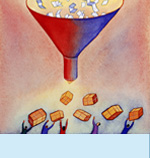


  |
||||
|
PRINTER FRIENDLY VERSION Customer-Driven Marketing Listening to Who's Really Calling the Shots - Your Customer Do you know what your customers experience when they walk through your door or call your customer hotline? Do your employees put your customers first? If you don't know the answers to these questions, it's unlikely that you're conducting customer-driven marketing. Customer-driven marketing involves seeing your products or services from your customer's perspective and communicating your messages in the customer's language. This approach goes beyond traditional textbook branding and positioning, which are driven by the marketer, to getting an outside-in perspective and designing a marketing strategy that is driven by the customer's needs. The key to obtaining an outside-in perspective lies in conducting beneath-the-surface customer and employee research. The Psychology of Customer-Driven Marketing My training and experience in psychology emphasized working to understand my clients' experiences in their daily lives. What is it like to be him or her, to live within that marriage or to work in that job? In addition, what factors in the client's life contribute to a system that has resulted in the current situation? What will it take to make some changes? This experiential approach led to the creation of our three-step process for developing effective customer-driven marketing: 1. What do your customers experience? 2. What's it like to be your employee? 3. What systemic factors contribute to maintaining the current condition? (And what's it going to take to change it?) We include employees in our approach because they are absolutely critical to enabling an organization to meet customer needs. Beyond employees' primary functions, they also serve another vital role — they are advocates for the brand. Supporting employees so they are equipped and motivated to promote the organization at every point of contact may be one of the most important and effective ingredients in building market share. Simply put, engaged and motivated employees who understand the brand and where it is going translate to happy customers. After all, an organization can devote unlimited advertising proclaiming that it is customer-focused, but nothing conveys this more clearly than how the customer service employee or receptionist answers the phone. Take A Close Look Customer-driven marketing understands customers as people making decisions based on their needs and frames of reference rather than as consumers defined by media habits and demographics. The process involves taking a close look at the customers and employees who have a relationship with your product or service and developing a marketing strategy and messages that are credible, compelling and differentiating. For example, the following insights obtained from our market research were invaluable to the development of an effective customer-driven marketing approach: • Women are more comfortable thinking about a prescription creme that reduces wrinkles as a cosmetic. The idea of needing to apply the creme regularly is more acceptable if they think of it like coloring their hair rather than taking a prescription drug long-term. This understanding led to the public relations launch of Johnson & Johnson's Renova at department store cosmetic counters staffed by personable dermatologists rather than a more traditional medical product introduction. • Mango consumers feel so passionately about their favorite fruit's distinct flavor that they actually crave it. Yet in the U.S., only one in three customers has ever tasted a mango because many aren't familiar with how to select, cut and prepare one. Knowing about mango's many healthful benefits as well as learning how to select and cut mangos and use recipes for cooking with them reinforces the more emotional appeal of the fruit and invites people to try it. Mangos from Mexico's web site, marketing materials and knowledgeable merchandising representatives therefore communicate both mangos' powerful imagery as well as very practical information about preparation. • Jim Beam drinkers associate their brand with bonding among friends, their great interest in the outdoors and a tradition of enjoying their favorite bourbon that began, for many, with their fathers. This comprehension resulted in the creation of the brand's Kentucky Bourbon Circle association that now numbers 80,000 premium bourbon drinkers who enjoy a newsletter and tasting events led by bourbon experts who address their interests. Case Study — Improving Customer Service The following case study shows how our three-step process led to understanding both customers and employees and development of a systemic approach to marketing. A major retail chain experiencing a significant downturn in sales retained us to conduct focus groups with consumers about how to improve customer service. Step One: Understanding the Customer Experience Our interviews suggested that receiving good service was a powerful experience for customers. They described doing a double-take when noticing employees communicating in a way that felt genuine. As one customer noted, "At the Ontario store, the person waiting on me was really very friendly. Not just the usual 'thanks for coming'. The way he said it was different. It caught my attention and made me feel like he actually cared. It made me want to come back to that particular store." We used our interviews to drill down and identify the cues of good service to target consumers. "How do you know you're getting good service?" we asked. "And why is that important?" These questions helped us identify that making eye contact, smiling and asking if customers need assistance to their cars suggested that employees care. Unfortunately, customers noted that the service they received was erratic and particularly varied among retail locations. Step Two: Understanding the Employee Experience Clearly, a customer service training program was needed for employees. But before developing the program, we conducted research to understand the employee experience to ensure that the training would provide the support they needed. It was no surprise to learn that training varied dramatically between store locations because store managers viewed the time involved as lost income, creating a system that didn't encourage employee training. Employees who didn't receive training felt embarrassed and ashamed that they couldn't be more helpful to customers. As one explained, "They put me on the register right away during the holiday rush and I didn't know how it worked. Customers were yelling at me...it was awful." Step Three: Understanding the System On the other hand, employees who had received training and engaged in good service behaviors reported feeling valued by their customers. Feeling valued, in turn, led to employees feeling proud to work for the chain and, for some, even aspiring to remain with the company and become a manager. Overall, customer reactions to good service were also a strong reinforcer for employees. The commitment and ambition of properly trained employees supported a system that encouraged further training. Understanding both the customer and employee experience for this organization was invaluable for developing an effective program to improve service delivery. The input from employees was instrumental in presenting the benefits of properly training employees to their store managers and gaining their support. With improved service, this business has experienced a dramatic rebound, with double digit sales increases. Customer-driven marketing helps organizations cut through the clutter and meet the bottom line of the people that matter most — the ones paying for the product or service. NEXT ARTICLE Jenny Schade is president of JRS Consulting, Inc., a firm that helps organizations build leading brands and efficiently attract and retain employees and customers. Subscribe to the free JRS newsletter on www.jrsconsulting.net/newsletter.html © JRS Consulting, Inc. 2007 |
 |
|||
© 2008 JRS Consulting, Inc.